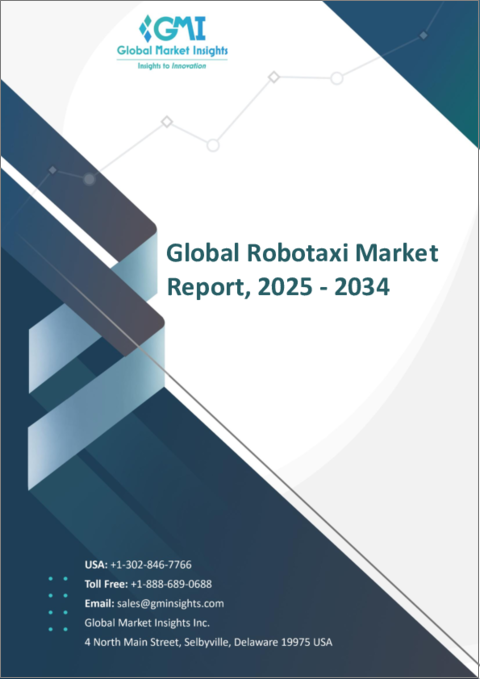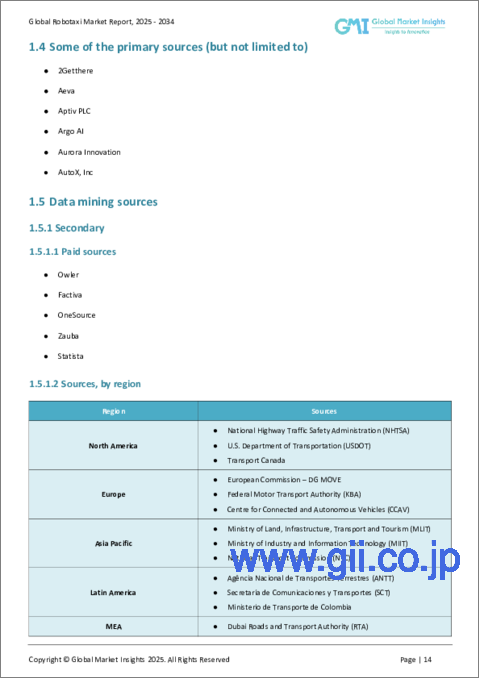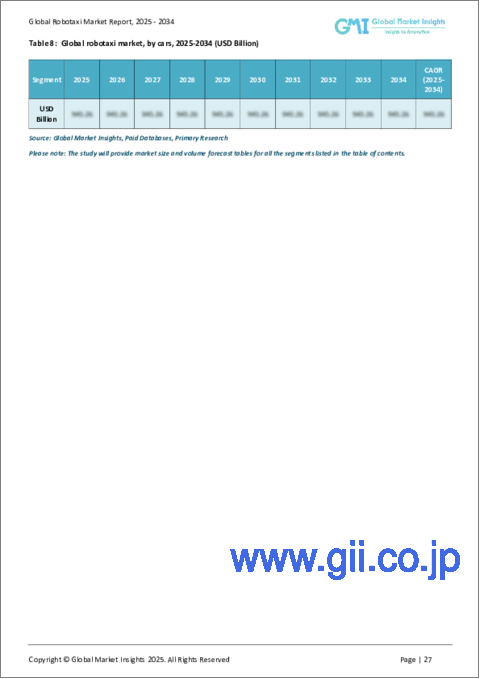|
|
市場調査レポート
商品コード
1544590
ロボットタクシー市場、市場機会、成長促進要因、産業動向分析と予測、2024-2032年Robotaxi Market, Opportunity, Growth Drivers, Industry Trend Analysis and Forecast, 2024-2032 |
||||||
カスタマイズ可能
|
|||||||
| ロボットタクシー市場、市場機会、成長促進要因、産業動向分析と予測、2024-2032年 |
|
出版日: 2024年07月03日
発行: Global Market Insights Inc.
ページ情報: 英文 220 Pages
納期: 2~3営業日
|
全表示
- 概要
- 目次
ロボットタクシーの世界市場は、自動運転車の安全性と信頼性を高める自律走行技術の進歩により、2024年から2032年までのCAGRが75%を超えるとみられています。
また、大手テクノロジー企業や自動車メーカーからの投資が増加しており、ロボットタクシーサービスの展開が加速しています。便利で費用対効果の高い交通ソリューションに対する消費者需要の高まりは、ロボットタクシーが従来のタクシーサービスに代わる手頃で効率的な選択肢を提供することを約束するため、市場拡大に寄与しています。支持的な規制の枠組みやスマートシティ構想は、自律走行型タクシーの採用に有利な条件を作り出しています。
一例を挙げれば、バイドゥは2024年3月、武漢でApollo Goを通じて中国初の24時間365日対応のロボットタクシー・サービスを開始し、自律走行における大きな進歩を示しました。このサービスはバイドゥの自律走行型ライドヘイリングプラットフォームを拡大するもので、完全な無人運転とユーザー中心のイノベーションを特徴としています。
ロボットタクシー市場は、車両タイプ、用途、サービスタイプ、最終用途、地域によって分類されます。
バン・セグメントは、その多用途性と、標準的な自動車と比較してより多くの乗客と貨物を収容する能力により、予測期間中に顕著なCAGRを示すと思われます。バンベースのロボットタクシーは、個人とグループの両方の輸送ニーズにとって理想的なソリューションと見なされ、快適性とスペースが強化されています。家族旅行、ライドシェアリングサービス、ラストワンマイル配達など、多様な用途に対応できることから、より魅力的な選択肢となっています。
旅客輸送分野は、2032年までにロボットタクシー市場の注目すべきシェアを占めると思われます。便利なオンデマンド交通ソリューションへの嗜好の高まりが、従来のタクシーやライドシェアに代わるコスト効率の高い選択肢を提供するロボットタクシーの採用を加速させています。シームレスな予約プロセス、リアルタイムの追跡、パーソナライズされたユーザー体験など、旅客輸送アプリケーションの革新により、顧客満足度が向上しています。急速な都市化と拡張性のある輸送ソリューションの必要性により、旅客輸送セグメントのシェアは拡大します。
2032年までに、欧州のロボットタクシー市場は大きな収益シェアを獲得します。厳しい環境規制がよりクリーンな輸送ソリューションを支持し、自律走行EVが魅力的な選択肢として位置づけられるからです。AIとセンサー・システムの技術的進歩が、ロボットタクシー・サービスの安全性と信頼性を高めています。さらに、欧州ではスマートシティ構想や公共交通機関の近代化に力を入れており、自律走行車の既存交通システムへの統合を後押ししています。便利で効率的かつ持続可能なモビリティ・ソリューションに対する消費者の関心は、欧州全域でロボットタクシー産業の成長をさらに促進すると思われます。
目次
第1章 調査手法と調査範囲
第2章 エグゼクティブサマリー
第3章 業界洞察
- エコシステム分析
- ベンダー・マトリックス
- 利益率分析
- テクノロジーとイノベーションの展望
- 特許分析
- 主要ニュースと取り組み
- 規制状況
- 影響要因
- 促進要因
- 自律走行技術の進歩
- 都市化と交通渋滞
- 環境規制と持続可能性の目標
- 経済性とコスト効率
- 消費者の嗜好の変化と技術的受容
- 業界の潜在的リスク&課題
- 規制状況と法的枠組み
- 技術の複雑さと運営上の課題
- 促進要因
- 成長可能性分析
- ポーター分析
- PESTEL分析
第4章 競合情勢
- イントロダクション
- 企業シェア分析
- 競合のポジショニング・マトリックス
- 戦略展望マトリックス
第5章 市場推計・予測:2021年~2032年、自動車タイプ別
- 主要動向
- 自動車
- バン
第6章 市場推計・予測:用途別、2021年~2032年
- 主要動向
- 貨物輸送
- 旅客輸送
第7章 市場推計・予測:サービスタイプ別、2021年~2032年
- 主要動向
- レンタカー
- 駅
第8章 市場推計・予測:エンドユース別、2021年~2032年
- 主要動向
- シェアードモビリティ
- コーポレートフリート
第9章 市場推計・予測:地域別、2021年~2032年
- 主要動向
- 北米
- 米国
- カナダ
- 欧州
- 英国
- ドイツ
- フランス
- イタリア
- スペイン
- その他欧州
- アジア太平洋
- 中国
- インド
- 日本
- 韓国
- その他アジア太平洋地域
- ラテンアメリカ
- ブラジル
- メキシコ
- その他ラテンアメリカ
- 中東・アフリカ
- UAE
- サウジアラビア
- その他中東・アフリカ
第10章 企業プロファイル
- 2Getthere
- Aeva
- Aptiv PLC
- Argo AI
- Aurora Innovation
- AutoX, Inc
- Baidu, Inc.
- Beijing Didi Chuxing Technology Company Ltd
- Beijing Xiaoju Technology Co., Ltd.
- Cruise LLC
- EasyMile
- Einride
- Local Motors
- Lyft, Inc
- May Mobility
- Motional, Inc
- Navya
- Nuro
- Oxbotica
- PONY.AI
- Uber Technologies, Inc
- Velodyne Lidar
- Voyage
- Waymo LLC
- Zoox, Inc
Global Robotaxi Market is set to experience over 75% CAGR from 2024 to 2032, due to advancements in autonomous vehicle technology that enhance the safety and reliability of self-driving cars. Additionally, growing investments from major technology companies and automotive manufacturers are accelerating the deployment of robotaxi services. The increased consumer demand for convenient and cost-effective transportation solutions contributes to market expansion, as robotaxis promises to offer affordable and efficient alternatives to traditional taxi services. The supportive regulatory frameworks and smart city initiatives are creating favorable conditions for the adoption of autonomous taxis.
Quoting an instance, in March 2024, Baidu launched China's first 24/7 robotaxi service through Apollo Go in Wuhan, marking a major advancement in autonomous driving. This service expands Baidu's autonomous ride-hailing platform, featuring fully driverless rides and a focus on user-centric innovations.
The robotaxi market is categorized based on vehicle type, application, service type, end use, and region.
The vans segment will exhibit a noteworthy CAGR during the forecast period, owing to their versatility and capacity to accommodate more passengers and cargo compared to standard cars. Van-based robotaxis are viewed as ideal solutions for both individual and group transportation needs, offering enhanced comfort and space. Their ability to serve diverse applications, such as family travel, ride-sharing services, and last-mile delivery, makes them a more attractive option.
The passenger transport segment will hold a notable robotaxi market share by 2032. The increasing preference for convenient, on-demand transportation solutions has accelerated the adoption of robotaxis, which offers a cost-effective alternative to traditional taxis and ride-shares. Innovations in passenger transport applications, such as seamless booking processes, real-time tracking, and personalized user experiences, are improving customer satisfaction. With rapid urbanization and the need for scalable transport solutions, the passenger transport segment share will proliferate.
By 2032, the Europe robotaxi market will capture a significant revenue share, as stringent environmental regulations favor cleaner transportation solutions, positioning autonomous EVs as a compelling choice. Technological advancements in AI and sensor systems are enhancing the safety and reliability of robotaxi services. Additionally, Europe's focus on smart city initiatives and public transportation modernization is supporting the integration of autonomous vehicles into existing transit systems. Consumer interest in convenient, efficient, and sustainable mobility solutions will further propel the growth of the robotaxi industry across Europe.
Table of Contents
Chapter 1 Methodology and Scope
- 1.1 Market scope and definition
- 1.2 Base estimates and calculations
- 1.3 Forecast calculation
- 1.4 Data sources
- 1.4.1 Primary
- 1.4.2 Secondary
- 1.4.2.1 Paid sources
- 1.4.2.2 Public sources
Chapter 2 Executive Summary
- 2.1 Industry 360° synopsis, 2021 - 2032
Chapter 3 Industry Insights
- 3.1 Industry ecosystem analysis
- 3.2 Vendor matrix
- 3.3 Profit margin analysis
- 3.4 Technology and innovation landscape
- 3.5 Patent analysis
- 3.6 Key news and initiatives
- 3.7 Regulatory landscape
- 3.8 Impact forces
- 3.8.1 Growth drivers
- 3.8.1.1 Advancements in autonomous driving technology
- 3.8.1.2 Urbanization and traffic congestion
- 3.8.1.3 Environmental regulations and sustainability goals
- 3.8.1.4 Economic viability and cost efficiency
- 3.8.1.5 Changing consumer preferences and technological acceptance
- 3.8.2 Industry pitfalls and challenges
- 3.8.2.1 Regulatory landscape and legal frameworks
- 3.8.2.2 Technological complexity and operational challenges
- 3.8.1 Growth drivers
- 3.9 Growth potential analysis
- 3.10 Porter's analysis
- 3.10.1 Supplier power
- 3.10.2 Buyer power
- 3.10.3 Threat of new entrants
- 3.10.4 Threat of substitutes
- 3.10.5 Industry rivalry
- 3.11 PESTEL analysis
Chapter 4 Competitive Landscape, 2023
- 4.1 Introduction
- 4.2 Company market share analysis
- 4.3 Competitive positioning matrix
- 4.4 Strategic outlook matrix
Chapter 5 Market Estimates and Forecast, By Vehicle Type, 2021 - 2032 (USD Million)
- 5.1 Key trends
- 5.2 Cars
- 5.3 Vans
Chapter 6 Market Estimates and Forecast, By Application, 2021 - 2032 (USD Million)
- 6.1 Key trends
- 6.2 Good transport
- 6.3 Passenger transport
Chapter 7 Market Estimates and Forecast, By Service Type, 2021 - 2032 (USD Million)
- 7.1 Key trends
- 7.2 Car rental
- 7.3 Station based
Chapter 8 Market Estimates and Forecast, By End Use, 2021 - 2032 (USD Million)
- 8.1 Key trends
- 8.2 Shared mobility
- 8.3 Corporate fleet
Chapter 9 Market Estimates and Forecast, By Region, 2021 - 2032 (USD Million)
- 9.1 Key trends
- 9.2 North America
- 9.2.1 U.S.
- 9.2.2 Canada
- 9.3 Europe
- 9.3.1 UK
- 9.3.2 Germany
- 9.3.3 France
- 9.3.4 Italy
- 9.3.5 Spain
- 9.3.6 Rest of Europe
- 9.4 Asia Pacific
- 9.4.1 China
- 9.4.2 India
- 9.4.3 Japan
- 9.4.4 South Korea
- 9.4.5 Rest of Asia Pacific
- 9.5 Latin America
- 9.5.1 Brazil
- 9.5.2 Mexico
- 9.5.3 Rest of Latin America
- 9.6 MEA
- 9.6.1 UAE
- 9.6.2 Saudi Arabia
- 9.6.3 Rest of MEA
Chapter 10 Company Profiles
- 10.1 2Getthere
- 10.2 Aeva
- 10.3 Aptiv PLC
- 10.4 Argo AI
- 10.5 Aurora Innovation
- 10.6 AutoX, Inc
- 10.7 Baidu, Inc.
- 10.8 Beijing Didi Chuxing Technology Company Ltd
- 10.9 Beijing Xiaoju Technology Co., Ltd.
- 10.10 Cruise LLC
- 10.11 EasyMile
- 10.12 Einride
- 10.13 Local Motors
- 10.14 Lyft, Inc
- 10.15 May Mobility
- 10.16 Motional, Inc
- 10.17 Navya
- 10.18 Nuro
- 10.19 Oxbotica
- 10.20 PONY.AI
- 10.21 Uber Technologies, Inc
- 10.22 Velodyne Lidar
- 10.23 Voyage
- 10.24 Waymo LLC
- 10.25 Zoox, Inc





